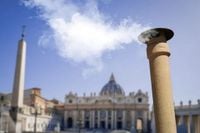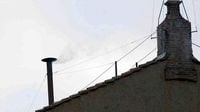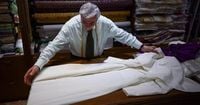Pope Francis died on April 21, 2025, at 7:35 AM at the age of 88 after a prolonged struggle with health issues. Following his passing, the Vatican is preparing for a conclave to elect his successor, which is set to begin within 15 to 20 days, placing it in early May 2025.
The conclave, a gathering of cardinal electors, will take place under strict conditions of secrecy and isolation. The name "conclave" originates from the Latin term for "closed room," reflecting the protocol that isolates the cardinals from the outside world during the election process. This ensures that no external pressures influence their decision. Each cardinal will take an oath of silence and reside at the Dom Świętej Marty until the conclave concludes.
Voting will continue until a candidate secures the required two-thirds majority. The ballots will be written on slips of paper and burned after each voting session. Black smoke will signal that no successor has been chosen, while white smoke will indicate that a new pope has been elected.
As anticipation builds, the world is watching closely for the iconic white smoke to rise from the Sistine Chapel. Chris Mocella, author of "Chemia pirotechniki," explained that the production of white smoke involves burning specific chemical compounds. "Advanced chemical knowledge is not necessary for this," he stated, noting that the cardinals utilize a simple combustion process involving zinc and sulfur to generate the smoke. Black smoke, on the other hand, is produced through the incomplete combustion of organic materials like wood.
Since May 6, 2025, the cardinals have been sequestered in the Vatican, devoid of contact with the outside world, including phones and computers. Each day, they will participate in solemn Mass at 10 AM before proceeding in procession to the Sistine Chapel, where they will pray for the guidance of the Holy Spirit.
The Vatican is already prepared for the announcement of "Habemus Papam"—Latin for "We have a Pope." In the sacristy of the Sistine Chapel, known colloquially as the "Room of Tears," three sets of papal vestments and seven pairs of shoes await the new pope. These garments are tailored in small, medium, and large sizes to ensure an appropriate fit for the new leader of the Catholic Church.
Raniero Mancinelli, an 86-year-old Roman tailor with over seven decades of experience, is responsible for crafting these ceremonial garments. His workshop is located just steps away from St. Peter's Square, and he has dedicated his craft to serving the clergy.
In addition to the cassocks, the attire includes a red mozzetta, a short cape traditionally worn by the pope. However, it is noteworthy that Pope Francis opted not to wear this garment after his election in 2013, instead choosing to emphasize simplicity and humility by appearing in just a white cassock.
The "Room of Tears" derives its name from the emotional responses often felt by the newly elected cardinal as he prepares to don the papal attire for the first time. This moment is typically filled with deep emotion and a profound sense of responsibility.
As the conclave progresses, the world awaits the historic announcement of "Habemus Papam" from the balcony of St. Peter's Basilica. This tradition, dating back to the 15th century, is a significant moment in the papal election process. The first recorded instance of this announcement occurred in 1484 when Cardinal Francesco Piccolomini proclaimed the election of Pope Innocent VIII.
Upon the declaration of "Habemus Papam," the newly elected pope will appear on the balcony to give his first blessing, "Urbi et Orbi"—to the city and the world. The excitement surrounding the conclave is palpable, with many speculating on potential candidates, including Cardinal Pietro Parolin.
White smoke is produced by burning the ballots with the addition of specific chemical substances such as potassium chlorate and lactose. Conversely, black smoke arises from the combustion of ballots with sulfur and nitrates, indicating that no decision has yet been reached.
The election process is governed by the constitution "Universi Dominici gregis," which outlines the rules surrounding the vacancy of the Apostolic See and the election of a new pope. Only cardinals under the age of 80 at the time of the pope's death or at the onset of the vacancy are eligible to participate in the conclave. This regulation was established to ensure that the electors are capable of fulfilling their duties.
Throughout the conclave, strict confidentiality is maintained. Cardinals are prohibited from any form of communication with the outside world, including written correspondence, phone calls, or social media interactions. The only individuals permitted to communicate with the cardinals are those who are essential for the conclave's operations, and even they must take an oath of silence.
If no pope is elected within three days of voting, a one-day break is mandated for prayer and meditation. Following this, the cardinals will resume voting, with the process continuing until a candidate receives the necessary majority. If a candidate is elected, the presiding cardinal will ask if he accepts the election and how he wishes to be addressed as pope.
Once the new pope accepts his election, he will proceed to the "Room of Tears" to put on the papal garments for the first time. Following this emotional moment, he will be greeted by the other cardinals, who will express their respect and obedience. The announcement of "Habemus Papam!" will then be made to the world, marking the beginning of a new papacy.
The anticipation surrounding the conclave and the subsequent election of a new pope is a significant moment for the Catholic Church and its followers worldwide. As the world watches, the hope for a new leader who will guide the Church in the years to come rests in the hands of the cardinal electors.






